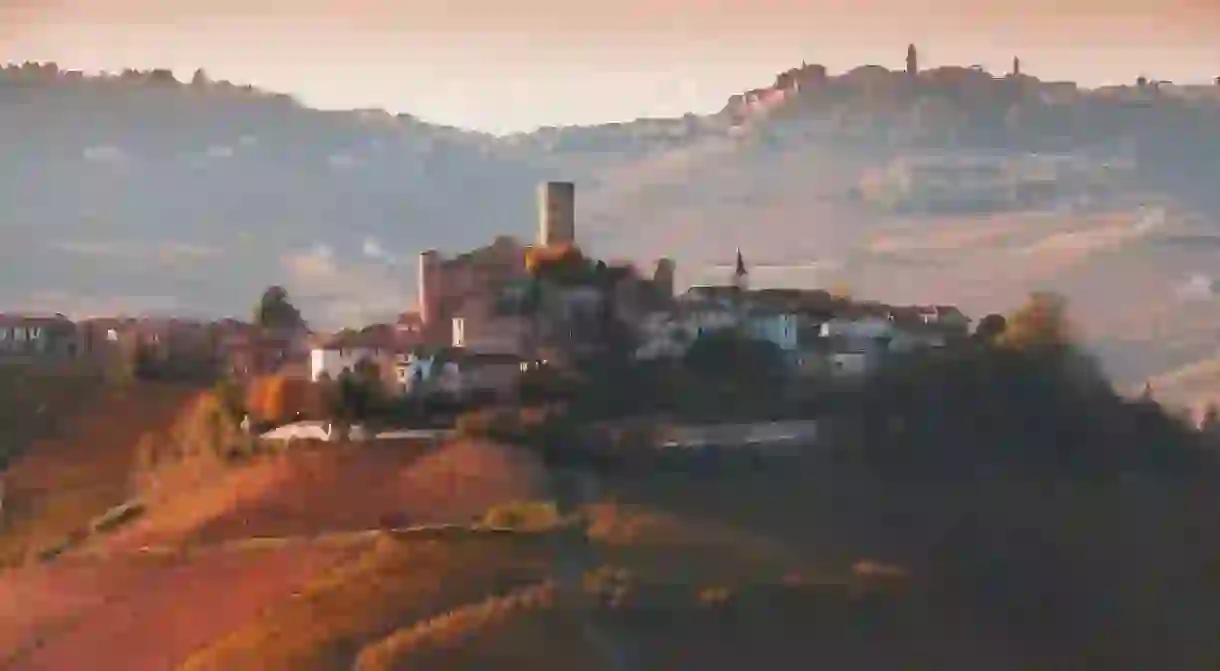Wine, Culture and Gastronomy - Exploring Italy's Piedmont Region

Piedmont, Italy’s second-largest region, is a land of rugged peaks and verdant hills sitting at the foot of the Alps. A haven for wine connoisseurs, truffle lovers, history buffs and fans of the Slow Food movement, the charming area offers a diverse range of sights from family-owned wineries to UNESCO World Heritage Sites.
Piedmont oozes authenticity. Slow-paced, its rural areas are surrounded by stunning pastoral landscapes and regal piazzas. In the small town of Alba, you’ll experience a traditional lifestyle in a setting where vineyards producing world-class wine are dotted around town. Situated in the heart of the Langhe region, a two-hour car ride from Milan’s Malpensa airport, Alba is a small town that keeps on giving. The under-the-radar destination is the home of notorious chocolate companies Ferrero Roche and Nutella, with small-sized hazelnut trees planted around the municipality.
A prime wine destination
There’s no denying that there is an abundance of high-quality wine in Alba and its surrounding villages, including Asti and Roero, a UNESCO World Heritage Site since 2014. World-renowned vintages Barbera, Barolo and Barbaresco – made from red grapes – are produced in the region by family-owned wineries that have been producing wine for decades and some centuries, like Coppo in Canelli. Dating back to 1892, it’s one of the oldest family-run wineries in Italy.
For Pelassa Vini, run by Daniele Pelassa and his family, wine is a way of life. The extensive vineyard was created by his late father Mario over 60 years ago, turning a modest wine plantation into a successful family business. The grapevines on the territory are harvested by hand and softly pressed to not damage the fruits before fermentation. For red wines, that involves malolactic fermentation, a process that reduces the acidity in the wine before storing it in casks made of steel and wood until they are bottled in summer. White wines, on the other hand, such as their sparkly Spumante brut, are fermented at cooler temperatures to preserve the aroma of the wines before they are bottled in spring.
Cascina Chicco is a family-run vineyard sitting on the Roero hills overlooking the colourful old municipality of Roero. Enter the imposing white mansion-like property and visit the subterranean cave-like cellar that was carved by hand to gain an understanding of a wine journey that started in the 1950s. The land, acquired by butcher turned winemaker Ernesto Faccenda, expanded from one hectare to a whopping 44 hectares. Today, the winery is vinified in some of Roero’s most notable areas, including Vezza d’Alba and Canale.

Eat your way around
Unpretentious and simple, authentic Italian dishes are generally made from a handful of seasonal ingredients. Yet the diverse cuisine has distinctive flavours and aromas with recipes centred around family and tradition. Sampling local flavoursome food is one of the best ways to learn about a place and its heritage, as each area has its own specialities. In Piedmont, you can expect to munch on Vitello Tonnato, a typical dish from the region made up of a thinly sliced veal served in a tuna fish sauce. The appetiser is a staple food bound to make an appearance at local restaurants, including Volli, an intimate and dimly-lit eatery nestled in a small alleyway in the centre of Asti. The kitchen, led by chef Marco Toso, takes you on a culinary journey where risotto and hazelnut cake made with amaretti is also on the menu.
But the real star of the gastronomy is the truffle. With Piedmont being a prime location for truffle hunting, it’s not surprising that you can indulge in it everywhere. For a unique culinary experience, head to Enoclub, a downstairs wine cellar turned restaurant, to experience their tangy meals. The agnolotti del plin – a type of pasta stuffed with ricotta and wild herbs and topped with black truffles – is a divine dish that represents the disparate flavours of the region.

The white truffles capital of the world
Between September and January, Alba becomes one big truffle playground as the hunting season for white truffles takes place. Truffle hunters – with the help of trained dogs – often spend hours in the forests looking to find one of the biggest attractions of the area – a garlic-smelling fungus that people can’t get enough of.
To fully understand the art of truffle hunting, your best bet is to go on a tour where you’ll gain extensive knowledge about the experience, such as La Casa del Trifulau, run by brothers and truffle hunters Natale and Giorgio.
An enchanting medieval village
Walk along the cobbled streets of Neive, and you’re transported to a medieval village with a rich history. It’s considered one of the most beautiful villages in Italy – and rightfully so – with vividly-coloured buildings and romantic balconies that overlook the lush rolling hills. Take in the laid-back ambience as you dawdle along the streets and appreciate your surroundings. Admire the beauty of the community from higher altitudes by visiting Torre di Barbaresco, a 30 metres high gothic tower with panoramic views of the countryside. Immerse in art on the 1st floor with a small exhibition featuring original works of Andy Warhol, which takes place in September-December this year. Maximise your visit by attending a wine-tasting on the rooftop terrace as you embrace la Dolce vita – the sweet life. If hunger strikes, head to next-door restaurant Trattoria Antica Torre for a scrumptious meal of tajarin noodles – thin homemade egg pasta topped with parmesan – another typical dish of Piedmont.













